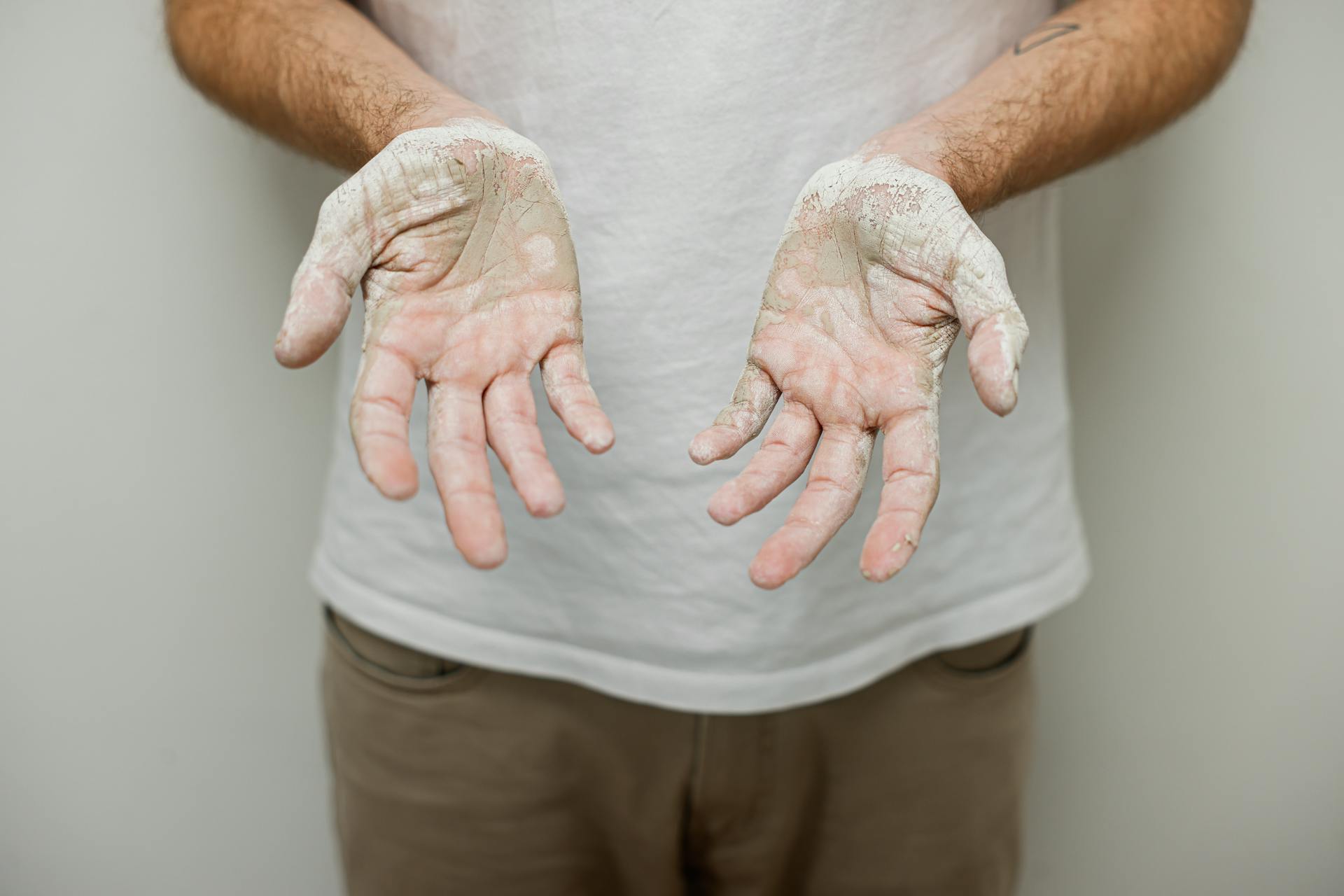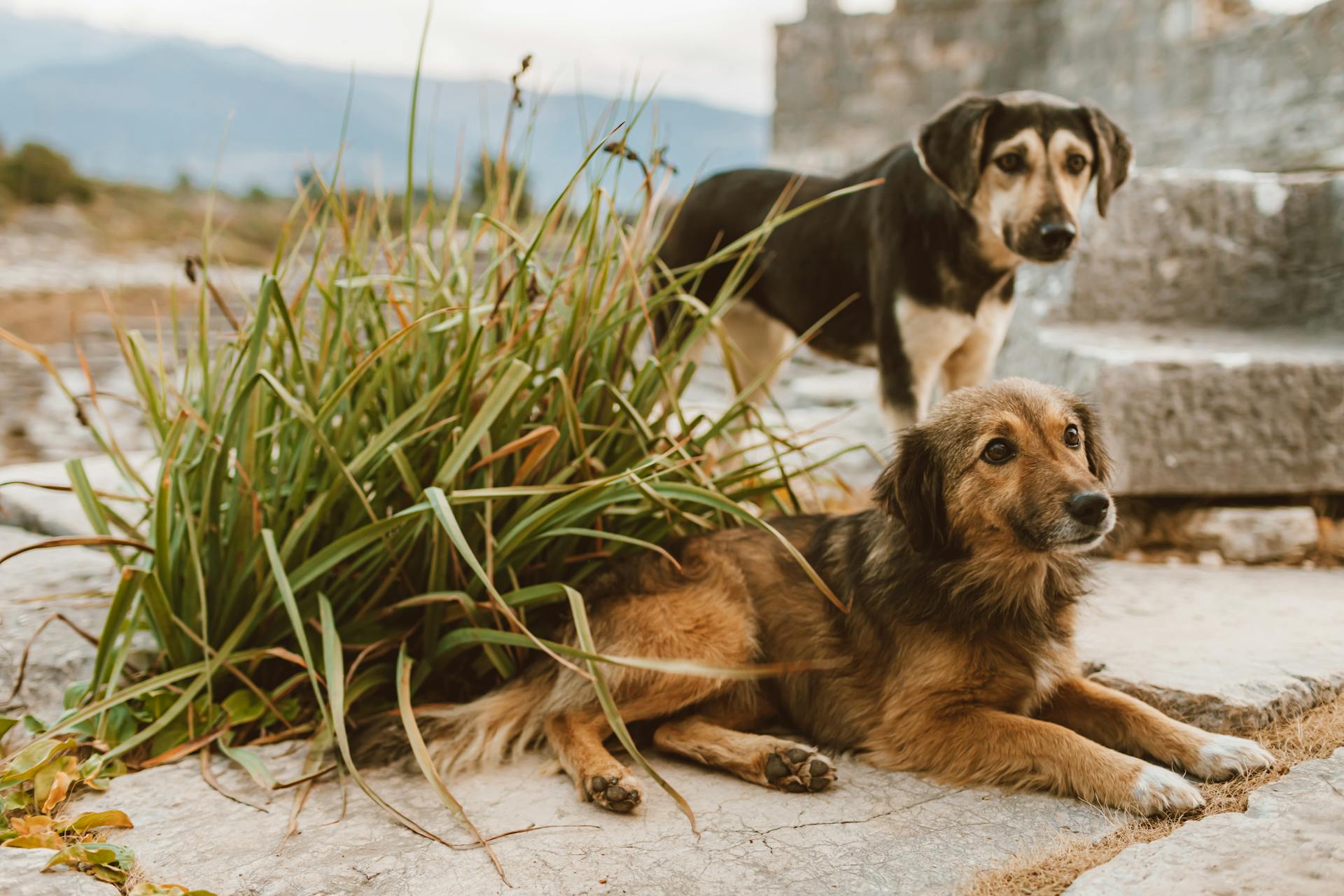
Alabama Rot, also known as Cutaneous and Renal Glomerular Vasculopathy (CRGV), is a rare and serious condition affecting dogs.
The exact cause of Alabama Rot is still unknown, but it's believed to be linked to environmental factors, such as exposure to certain plants, bacteria, or toxins.
Dogs of any age, breed, or size can be affected by Alabama Rot, but it's more common in certain regions, particularly in the UK.
Symptoms of Alabama Rot typically start with skin lesions, which can appear as red, swollen, or painful patches on the dog's legs, belly, or face.
See what others are reading: Alabama Rot Map
What Is Alabama Rot?
Alabama rot is a very rare, potentially life-threatening disease that affects dogs. It's also known as CRGV, or cutaneous and renal glomerular vasculopathy.
The disease blocks and damages the blood vessels in a dog's skin and kidneys. This can lead to serious health issues.
Affected dogs often develop ulcers or sores, usually on the bottom part of their legs. These sores can be a sign of the disease.
Kidney failure is a common outcome for dogs with Alabama rot. It's often fatal.
You might enjoy: Alabama Dog Names
Causes and Risk Factors
The exact cause of Alabama rot is still unknown, but researchers believe it may be linked to a parasite or bacteria.
Veterinary experts have theories, but there's no clear consensus yet. Some think it's caused by toxins produced by E. coli, but there's no evidence of E. coli in UK cases.
Wet muddy conditions may be connected to the cause of Alabama rot. Many affected dogs had been walking in muddy woodland areas before becoming ill.
The disease is described as suspected CRGV in the UK, and a comprehensive report by the British Veterinary Association in 2015 concluded that it's a disease of unknown cause.
Dogs that develop azotaemia have a poor prognosis, which makes diagnosing and treating the condition very difficult.
Intriguing read: Can Allergies Cause Swollen Lymph Nodes in Dogs
Symptoms and Diagnosis
Alabama rot is a serious condition that can affect dogs, and it's essential to recognize the symptoms and know how it's diagnosed.
The symptoms of Alabama rot can vary, but common signs include cutaneous lesions, pyrexia (fever), lethargy or malaise, anorexia, vomiting or retching, skin ulcers, and visible swelling.
These skin lesions typically appear below the knee or elbow, and occasionally on the face or at the bottom of the chest or abdomen. They may look like an area of redness, a cut, bruise, sting, or open sore.
Changes in appetite, drinking more, vomiting, and lethargy are signs of acute kidney injury, which can occur after the skin lesions appear.
Your vet will check your dog's general health, ask about recent activities, and explore other possible causes of the symptoms.
Here are the typical signs of Alabama rot:
- Skin sores, visible swelling, red patch, or skin defects not caused by a known injury.
- Changes in appetite - reduced appetite, drinking more, vomiting, and lethargy.
Remember, the majority of visible skin lesions will not be caused by Alabama rot disease, and most cases of kidney failure will be due to another cause.
Treatment and Prevention
Symptomatic treatment is the primary approach to managing Alabama rot, focusing on wound management and supportive care when kidney problems arise. Since 2013, some UK dogs have been successfully treated.
While there's no guaranteed way to prevent Alabama rot, researchers believe a link may exist with walking dogs in muddy and woodland areas. You can reduce the risk by keeping your dog away from very muddy areas and washing and drying them after a walk if they get wet or muddy.
Regularly cleaning and inspecting your dog's paws, especially after walks in muddy or wooded areas, can help spot early signs of skin lesions. Maintaining good hygiene is crucial in preventing the spread of the disease.
By limiting visits to areas with wet and muddy conditions, especially during rainy seasons, you can further reduce the risk of your dog contracting Alabama rot.
How Is Treated?
Treatment for Alabama rot is primarily symptomatic, focusing on wound management and supportive care. Some dogs have been successfully treated since 2013.
Dogs showing only skin ulcers will usually be treated non-invasively. Aggressive supportive therapy is needed when renal compromise occurs.
Since the disease is believed to spread via dogs' feet and legs, it's best to avoid walking dogs in suspected infected areas. This can help prevent infection.
Plasmapheresis, or therapeutic plasma exchange, has shown promise in treating advanced cases. It resulted in survival of 2 out of 6 dogs with advanced disease in 2018.
Dogs showing signs of kidney problems need more intensive supportive care. The survival rate is believed to be low, so supportive care should start as soon as possible.
Prevention

Prevention is key when it comes to Alabama rot, but it's essential to know that there's no guaranteed way to prevent it. Researchers believe there may be a link with walking dogs in muddy and woodland areas.
To reduce the risk, you can keep your dog away from very muddy areas. Washing and drying your dog after a walk if they get wet or muddy is also a good idea.
Here are some practical tips to help you prevent Alabama rot:
- Keep your dog away from very muddy areas
- Wash and dry your dog after a walk if they get wet or muddy
- Contact your vet immediately if you see any changes in your dog's behaviour or health
Regularly cleaning and inspecting your dog's paws, especially after walks in muddy or wooded areas, can help you spot any early signs of skin lesions. This is a crucial step in maintaining good hygiene.

Limiting visits to areas with wet and muddy conditions, especially during rainy seasons, can also help reduce the risk. After walks in potentially contaminated areas, thoroughly wash and dry your dog, paying extra attention to their paws and belly.
Be vigilant about any unusual changes in your dog's behaviour or appearance, such as skin lesions, lethargy, vomiting, or diarrhoea. If you notice any of these signs, consult your vet immediately.
Staying updated on Alabama Rot cases in your area can also help you learn which areas have been recently confirmed with cases.
Worth a look: Skin Care for Dogs with Allergies
How Common?
Alabama rot is a rare disease, with only about 150 dogs affected in the UK between November 2012 and March 2018.
Reports of Alabama rot seem to be on the increase, which could be because more dogs are becoming affected, or because vets and owners are more aware of the condition.
The number of cases in the US is not known, but it's worth noting that the disease was confined to greyhounds in many cases.
Between 2018 and 2020, the South West and South East regions had the highest proportion of Alabama Rot cases per 100,000 dogs in the UK.
As of 2017, there had been 103 suspected cases in the UK.
Frequently Asked Questions
Have any dogs survived Alabama rot?
Unfortunately, the exact number of surviving dogs is unknown due to the need for a post-mortem kidney sample to confirm the illness. Some vets have reported cases of dogs surviving Alabama rot, but these cases are anecdotal and not confirmed.
What is the breakthrough treatment for Alabama rot?
Therapeutic plasma exchange (TPE) is a breakthrough treatment that has successfully saved some dogs with Alabama rot by removing toxic substances and auto-antibodies from the blood. This treatment offers new hope for dogs affected by this condition.
Is Alabama rot contagious to other dogs?
Alabama Rot is not contagious to other dogs, as there's no evidence to suggest it spreads from one dog to another. However, if your dog shows symptoms, it's essential to consult a veterinarian for proper diagnosis and care.
How quickly does Alabama rot develop in dogs?
Alabama Rot can progress rapidly, with skin ulcers developing into acute kidney injury within days. This quick progression can lead to severe kidney damage and reduced or absent urination.
Sources
- https://en.wikipedia.org/wiki/Alabama_rot
- https://www.thekennelclub.org.uk/health-and-dog-care/health/health-and-care/a-z-of-health-and-care-issues/alabama-rot/
- https://www.bbc.com/news/uk-england-hampshire-68248909
- https://www.myvet.ie/news/179-alabama-rot-awareness
- https://www.cathcartandwinn.com/news/alabama-rot-awareness/
Featured Images: pexels.com


